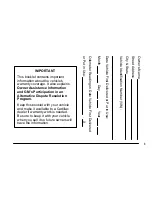
The repair methods given by the manufacturer in this document are based on the technical specifications, current at the time of release. The methods may be modified as a result of changes introduced by the manufacturer in the production of the various component
units and accessories from which the vehicles are manufactured. The reproduction, translation, transmission, in part of or whole of the present document,are prohibited without the prior written consent of Mahindra & Mahindra Ltd. The use of this document by any
person other than the trained personnel, at the Authorized Service Centre of Mahindra & Mahindra Ltd.,will amount to unauthorized use and shall be liable for penalty/prosecution
© 2013 Mahindra & Mahindra Ltd.
MAN-00233
MAY 2013/Rev 1
WIRING MANUAL
25042013
ESSENTIAL ELECTRICAL CONCEPTS
RESISTANCE:
Circuit load
−
The load has the highest resistance in a typical circuit. Other circuit elements
may be used to control current by providing additional resistance.
Resistance:
To get accurate resistance measuremen
ts, isolate the circuit or component and make
sure it is not connected to a power source.
Example:
Resistance used to control current:
•
Instrument panel lighting controlled by
dimmer switch.
•
Blower speed controlled by blower motor
resistors.
Excessive resistance
−
Excessive resistance in a circuit
can prevent it from operating normally. Loose,
damaged, or dirty connections are a common source
of excessive resistance.
Measure resistance with a DMM using the following
steps:
1. Make sure the circuit or component to be
tested is isolated and not connected to any
power source.
CAUTION:
Some meters may be damaged if you apply voltage to the meter leads when the
mode selector is set to measure resistance.
2. Set the DMM mode selector to measure resistance.
3. Select the Auto
−
range feature or manually select a range appropriate for the test.
4. Confirm the meter calibration by touching the meter’s two probes together.
−
For a typical DMM, resistance of the leads should be 0.2 ohms or less.
5. Connect the meter leads across the component or circuit segment to be tested.
6. Read the measured value on the DMM display.
−
Note the units.
200






































